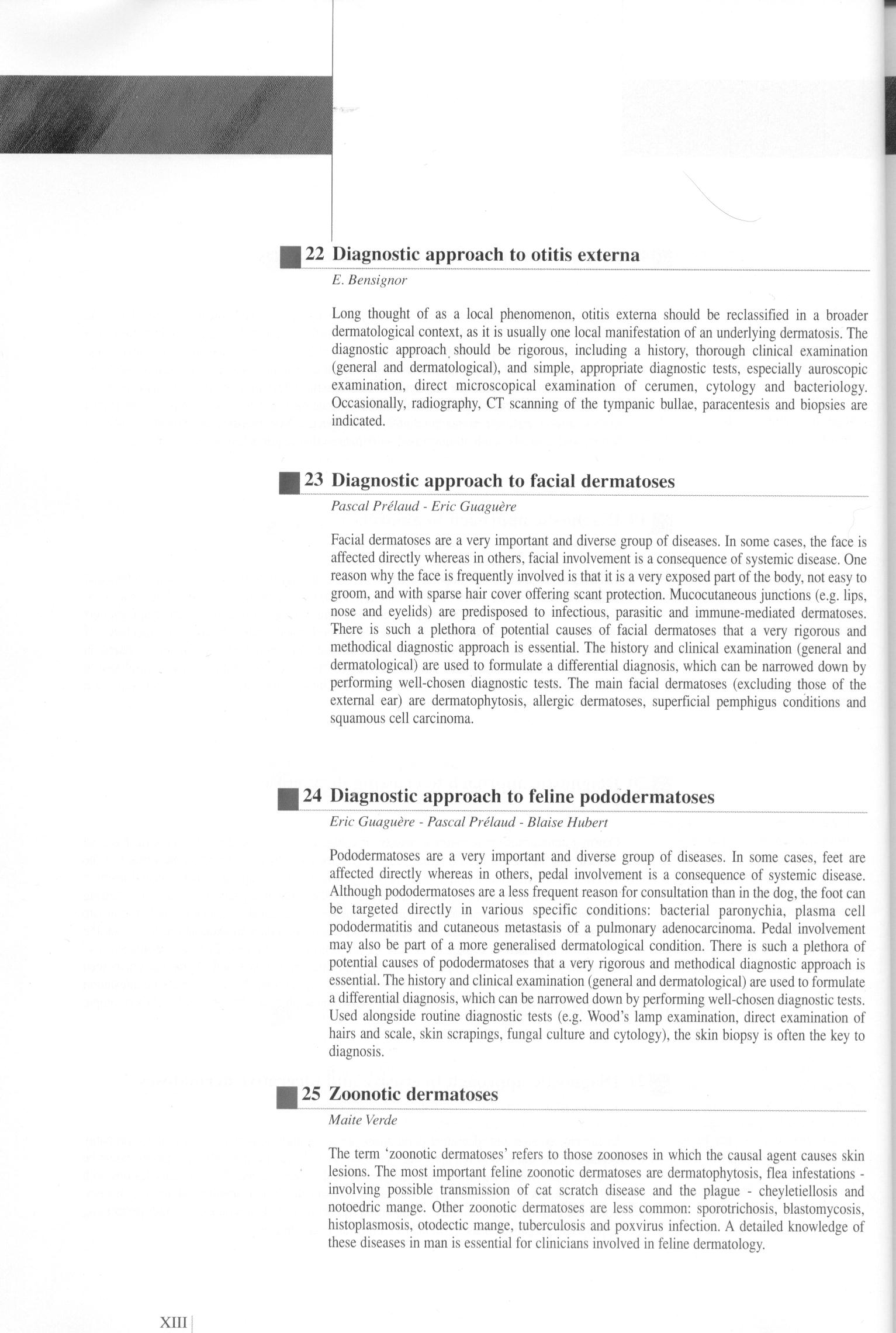7 (1239)

| 22 Diagnostic approach to otitis externa
E. Bensignor
Long thought of as a local phenomenon, otitis extema should be reclassified in a broader dermatological context, as it is usually one local manifestation of an underlying dermatosis. The diagnostic approach should be rigorous, including a history, thorough clinical examination (generał and dermatological), and simple, appropriate diagnostic tests, especially auroscopic examination, direct microscopical examination of cerumen, cytology and bacteriology. Occasionally, radiography, CT scanning of the tympanic bullae, paracentesis and biopsies are indicated.
|23 Diagnostic approach to facial dermatoses
Pascal Prelaud - Erie Guaguere
Facial dermatoses are a very important and diverse group of diseases. In some cases, the face is affected directly whereas in others, facial involvement is a conseąuence of systemie disease. One reason why the face is freąuently involved is that it is a very exposed part of the body, not easy to groom, and with sparse hair cover offering scant protection. Mucocutaneous junctions (e.g. lips, nose and eyelids) are predisposed to infectious, parasitic and immune-mediated dermatoses. There is such a plethora of potential causes of facial dermatoses that a very rigorous and methodical diagnostic approach is essential. The history and clinical examination (generał and dermatological) are used to formulate a differential diagnosis, which can be narrowed down by performing well-chosen diagnostic tests. The main facial dermatoses (excluding those of the extemal ear) are dermatophytosis, allergic dermatoses, superficial pemphigus conditions and sąuamous celi carcinoma.
J 24 Diagnostic approach to feline pododerinatoses
Erie Guaguere - Pascal Prelaud - Blaise Hubert
Pododermatoses are a very important and diverse group of diseases. In some cases, feet are affected directly whereas in others, pedał involvement is a conseąuence of systemie disease. Although pododermatoses are a less freąuent reason for consultation than in the dog, the foot can be targeted directly in various specific conditions: bacterial paronychia, plasma celi pododermatitis and cutaneous metastasis of a pulmonary adenocarcinoma. Pedał involvement may also be part of a morę generalised dermatological condition. There is such a plethora of potential causes of pododermatoses that a very rigorous and methodical diagnostic approach is essential. The history and clinical examination (generał and dermatological) are used to formulate a differential diagnosis, which can be narrowed down by performing well-chosen diagnostic tests. Used alongside routine diagnostic tests (e.g. Wood’s lamp examination, direct examination of hairs and scalę, skin scrapings, fungal culture and cytology), the skin biopsy is often the key to diagnosis.
25 Zoonotic dermatoses
Maite Verde
The term ‘zoonotic dermatoses’ refers to those zoonoses in which the causal agent causes skin lesions. The most important feline zoonotic dermatoses are dermatophytosis, flea infestations -involving possible transmission of cat scratch disease and the plague - cheyletiellosis and notoedric mange. Other zoonotic dermatoses are less common: sporotrichosis, blastomycosis, histoplasmosis, otodectic mange, tuberculosis and poxvirus infection. A detailed knowledge of these diseases in man is essential for clinicians involved in feline dermatology.
Wyszukiwarka
Podobne podstrony:
221 (22) Diagnostic approach to otitis extema Otitis extema is an acute or chronię inflammation of t
225 (20) 22 : Diagnostic approach to otitis extema Figurę 22:9: Erythematous, scaling lesions on the
227 (21) 22 : Diagnostic approach to otitis extema Figurę 22 :17: Invasive mast celi tumour in the e
223 (25) 22 : Diagnostic approach to otitis externa Figurę 22:1: Parasitic erythemato-ceruminous oti
233 (20) 23 : Diagnostic approach to facial dermatoses Figurę 23 : 1 : Depigmentation of the nasal p
6 (1069) g18 Diagnostic approach to pruritic dermatoses Z. Alhaidari The diagnostic approach to feli
235 (21) 23 : Diagnostic approach to facial dermatoses Figurę 23:9: Erythema, erosions and crusting
243 (19) 24 : Diagnostic approach to feline pododermatoses Figurę 24: 2 : Alopecia and rudimentary c
245 (17) 24 : Diagnostic approach to feline pododermatoses Figurę 24:10: Multiple paronychia with cr
247 (20) 24 : Diagnostic approach to feline pododermatoses Figurę 24 :18 : Crusting on the undersurf
249 (17) 24 : Diagnostic approach to feline pododermatoses Figurę 24:26: Multiple bacterial paronych
00044 d562ea1ca0756aca314d95625d46970 43A Rule-Based Approach to Multiple Statistical Test Analysis
lew Approaches to ronmental Challenges veleamfromthe long-run oftechnological systems? Franęois
StrućtliraI Linguistics Structural linguistics is an approach to linguistics wliich stresses the imp
29 (352) 2: Diagnostic approach Figurę 2:17: Sclerosis in a cat with morphea (courtesy of E. Bensign
231 (22) P. Prelaud - E. GuaguereDiagnostic approach to facial dermatoses Facial dermatoses are a ve
więcej podobnych podstron